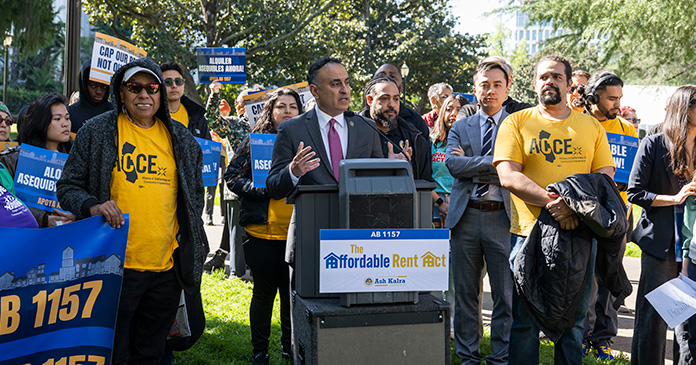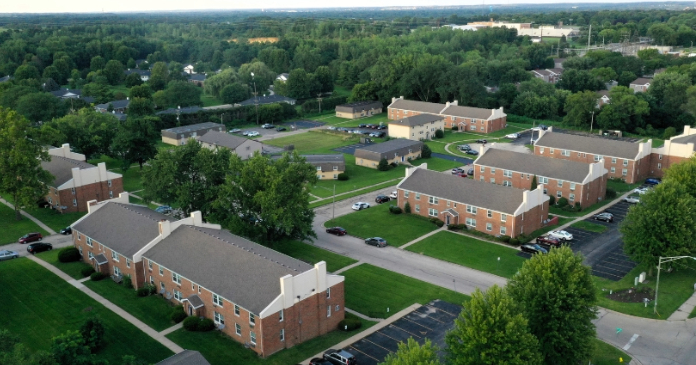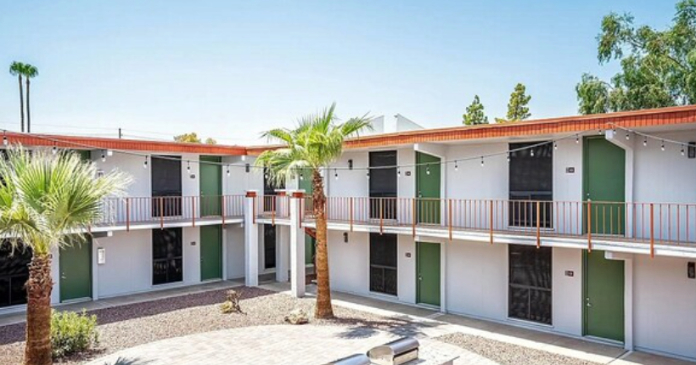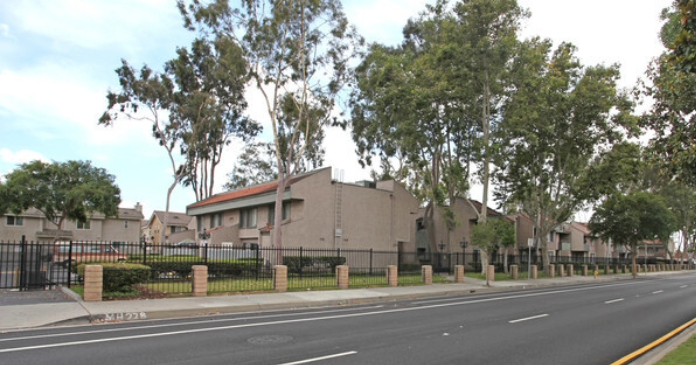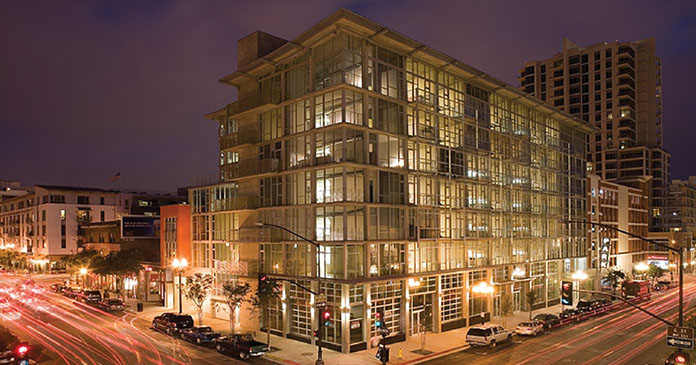
“It’s a little different right now, but it’s a pretty good dream,” Oliver said of the firm he and McMillan launched in 1978, now underway on nearly $1 billion in development, despite the economic climate. And that should be no surprise, since the company was born at the beginning of an economic downturn three decades ago. The new company broke ground on its first two projects—a strip shopping center in El Cajon, about 15 miles west of San Diego and a duplex in the Mission Hills neighborhood of Uptown San Diego—in 1980, finishing them as the prime interest rate hit 22 percent in 1982.
“Needless to say, we lost money on both those projects. We got out with our teeth. We had great designs and they were well executed, but really bad timing,” recalled Oliver of the company’s first projects, one of which won an American Institute of Architects design award.
Since then the firm has flourished. OliverMcMillan has developed and/or managed more than 10 million square feet of office, commercial, industrial, residential, retail, research and development and mixed-use projects over the past 32 years, with a total project value in excess of $2 billion, fulfilling the dream of the partners, who grew up in Point Loma, Calif., and went to school together from junior high through undergraduate school in business and real estate at UC-Berkeley and then on to business school and law school.
From vision to reality
Oliver embellished his upper education curriculum with art and architectural design courses. While still an undergraduate at Berkeley, he started a business silk-screening t-shirts in his parents’ backyard in Point Loma—first for the surfing crowd he and McMillan were part of while growing up, then for restaurants. “I did all the original design and printing and everything just dried by air,” he said of the business that helped pay for his education and ultimately provided some of the funding for the development business he and McMillan would create together. The operation had moved into a big factory in San Diego and had 50 employees by the time Oliver graduated from business and law school at 24 and joined a large law firm doing real estate work, while family members and friends ran the silk-screening operation.
McMillan was managing his family’s portfolio of real estate assets while Oliver was with the Luce Forward law firm for a couple of years before the partners launched OliverMcMillan, which 32 years later has a reputation for excellence in development of all commercial real estate products. The development firm specializes in complex urban and mixed-use deals, and has earned a reputation for efficient mitigation of brownfields and a successful track record of public/private partnerships.
Last month, Oliver recalled the series of up and down cycles he and McMillan have weathered over the years, and what they learned from each. The company’s “early failures” of the 1980s interest-rate debacle left them poorer, but wiser. “It was the beginning of a legacy of being a highly design-oriented firm that is very conscious of the built environment,” he said.
The business partners saw lots of competition in the early ’80s and realized that more than money was necessary to differentiate them from the development crowd. They decided an intense focus on cutting-edge design for complicated projects should be the hallmark of their company.
“That was our vision and the real truth is that probably hasn’t changed a whole lot, and we are still doing things that are very complex, things that many others wouldn’t want to tackle. And we still have great attention to detail and design and place-making. Those components have been expanded with relationships that have now spanned decades—with architectural firms, with construction firms, and with brokers, banks and bankers,” said the CEO of the company that is the biggest downtown landowner, other than the ball park, in San Diego.
“Our San Diego properties are either built and 95 percent leased or they’re sitting with land that is parking. They’re as small as a 10,000 sq. ft. piece of a block or as large as a full block. We have eight sites downtown waiting for development,” he said.
OliverMcMillan also owns 100 acres in Everett, Wash., where the company is working in partnership with the city and Principal Financial Group on a 225-acre mixed-use project along the Snohomish River, including 600,000 sq. ft. of retail, a 200-room hotel and around 1,000 residential units. In another public/private partnership, along with Principal Financial, on 60 acres in the historic Gausti District of Ontario in California’s Inland Empire, the company plans to build a 1.5 million sq. ft. mixed-use project that will include more than 250,000 sq. ft. of retail and restaurants, 500,000 sq. ft. of office, two hotels and 400 residential units. Both public/private revitalizations of a brownfield in Everett and a historic Winery in Ontario will break ground soon, after the most recent recession put them on hold for a while.
The company, also underway on three other large, urban projects in Iowa, San Diego and Hawaii, holds a stake in many of the previous mixed-use projects where it has overseen development and owns and manages about 2,000 apartments in San Diego, Houston and Chicago.
Reciting the litany of lessons he and his partners in the company have learned through their decades’ experience of up and down cycles, Oliver said. “Where we got hurt in the early ’90s was predominantly in office product, so we really stayed away from that for the most part, as a stand-alone project. And, certainly, office is going to be the most brutalized in this current downturn in terms of product types,” he said, adding that the company will only consider future office development in a mixed-use environment, “where there is a differentiated experience.”
Turning urban
It was in late ’80s and the early ’90s that the company refined its focus to urban projects with greater barriers to entry, Oliver explained. The lessons learned back in the early ’90s helped the company to weather this most recent storm less battered than many. This time around, the company had chosen products that are more resilient to economic downturns, a great deal of which involves urban residential.
“We are big believers in urban product and I’m a big believer in urban mixed-use product. This has been our focus since 1988. I think it is the way more of us are going to live in the future and it has proved to be a very good decision with respect to where we had our money and our partners’ money invested—either urban product or urban land,” he said.
The urban apartment product already has largely recovered in terms of value and entitled urban land is in the process of recovering, he reported, predicting that urban land will be the first land to be harvested for development, as the economy turns around.
“So, we have the land and the fundamental economics, and the financing is back to the point where we are very close to being able to launch money on pre-development of the new projects in Everett, Ontario, Iowa and Downtown San Diego,” said Oliver, adding that the company looks at every financial tool in the kit, from tax credits to Build America Bonds—many of which are going unused—to help fund the ongoing work. “Public/private partnerships will be key to jump-starting new vertical development,” he said.
The other lesson OliverMcMillan has learned over the years is to partner with cities with good political leadership and smart city managers, to work on projects that have no public opposition, in cities anxious enough to see revitalization that they will do whatever it takes to make a project happen, even in an era when banks are not in the mood for mega-lending.
“Right now we are in a period where big loans are out of vogue. So, a large project in America now is going be $100 million to $150 million and that will constrain what people are able to build for a while. There is a beginning pulse for development, but it is still a rather weak one,” he said.
“For most lenders, a very aggressive piece of a loan is $50 million. Most would prefer to stay in the $25 million tranche. So, if you’ve got a $100 million debt requirement, it takes four lenders in a syndicate to do it. Right now, on new development, if you can get the money, you’re probably not going to get more than half of what the cost is.”
How do you fill in the blanks? “More equity,” says Oliver. “And then that’s harder because the equity requires a much larger yield than the debt.”
So, while OliverMcMillan expects to work on some brand new ground-up development in the immediate future, another recession-wrought change in the company’s original vision is a focus on troubled development deals. “There’s a lot of broken real estate that needs to be fixed,” he said. “OliverMcMillan is pursuing broken deal opportunities, particularly the more complicated types of deals that have stalled.”
Mission impossible?
“There’s a whole category of projects where things stopped and weren’t finished. And that is not something that you can just take out a calculator and figure out how to fix. You have lots of issues dealing with what it costs to start construction back up. What’s it going to cost to finish it? What are the insurance issues, the warranty issues, the re-branding issues, the financing issues? What does the product want to be when it grows up?” he said, enumerating the questions OliverMcMillan asks about every “broken” project the firm undertakes nowadays.
And the company often is asked to look at those difficult projects by cities that have heard of the company’s success in other cities or was recommended by a happy customer who benefited from Oliver-McMillan’s expertise and unique method of figuring out how best to solve the problems and sort out the complexities of a project others wouldn’t want to touch.
Oliver said that much of success with those difficult projects starts with the design charette process the company began incorporating into the early planning stages for large, complex urban projects back in the 1990s.
The firm had worked up from $500,000 deals in its infancy to pushing $100 million when The Pike, a harbor redevelopment project in Long Beach, captured the interest of two real estate Goliaths—Trizac-Hahn, a big U.S. shopping center developer, and a large Japanese firm with a similar focus—and OliverMcMillan, the David of the trio of contenders.
The smaller company wasn’t sure it had a real chance, but created some initial design concepts and pro formas and, even though its two competitors merged to ensure their choice by the city to develop the project, OliverMcMillan won the deal.
The “uh-oh” factor
“My reaction was, ‘Uh-oh, we won,” recalled Oliver. The coastal gem of a site, partially separated from the water by a four-lane road used for the Long Beach Grand Prix, presented myriad complications.
Concerned about using only one design firm on such a complex project and, perhaps, missing an opportunity or making mistakes, OliverMcMillan decided to adapt the historic charette process to the company’s early planning efforts. Four design firms were given a program in advance and, after each brought forward their ideas separately, the four worked collectively, putting the best of those solutions to the various challenges to make the whole greater than the sum of those parts.
Oliver said the company found the exercise so successful that the firm has used that holistic design process again and again, with success after success. “It can involve 25 people, it can involve 100,” he said of the process that today brings in not just architects, contractors, engineers and brokers, but also government leaders, community activists, anyone with an interest in the project. The several-day process, during which ideas are shared and a vision begins to appear, has evolved considerably over time. “So we’ve really perfected an amazing method,” he said. “It’s a fascinating process and when vertical development comes back to the point where we can do it, we will continue to use this process.”
Oliver is seeing more optimism lately among his employees and peers, which may be a positive sign for the future. “I think that people realize that the earth is not going to split and they are not going to fall into the ocean,” he said, adding that people also realize job recovery will be slow.
“I think we’re still in an acceptance and adaptation period and things are moving in a better direction. But, I think we’re going to have some more bumps along the road this year and into next year. Hopefully, next year will be a better year than this year,” said Oliver, adding a bright note for the multihousing industry.
“Within all that, I think, in our industry, in our business, the brightest sector is multifamily. So, if there’s any sector that is beginning a stronger recovery than others, it’s multifamily,” he said.
Author Peggy Shaw







